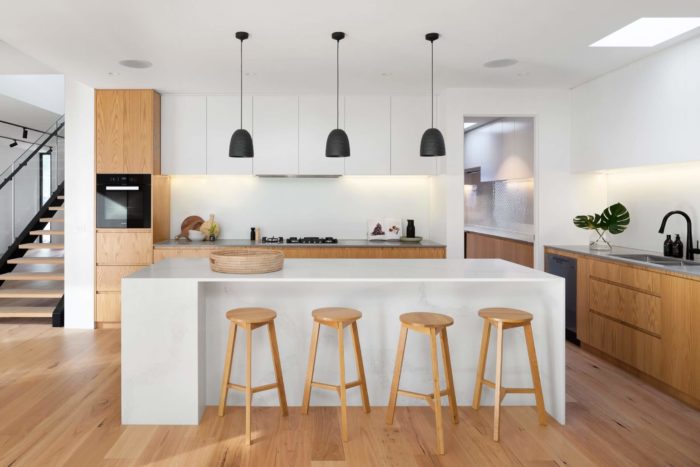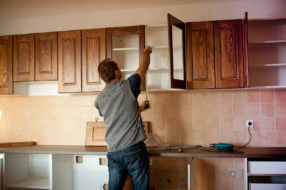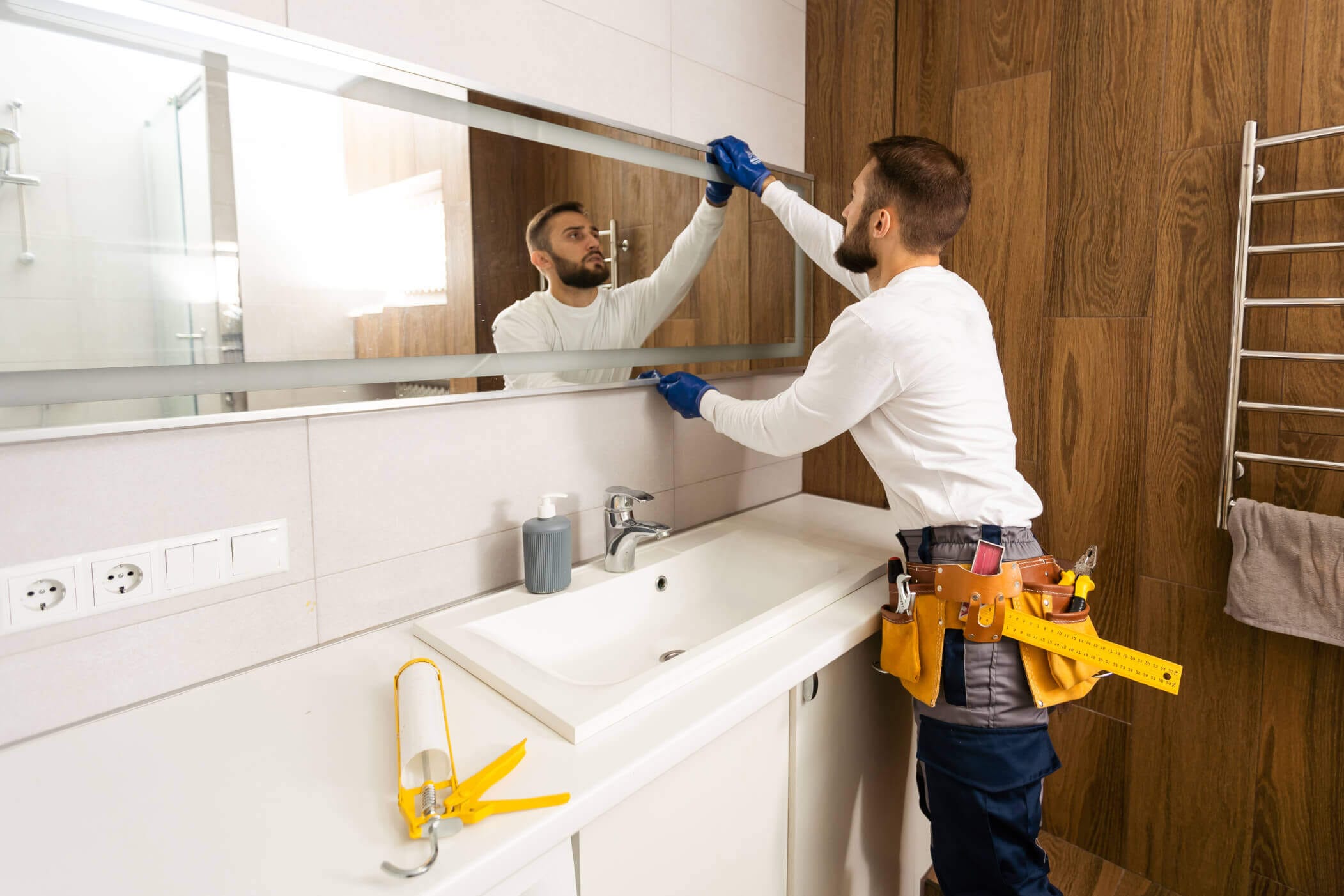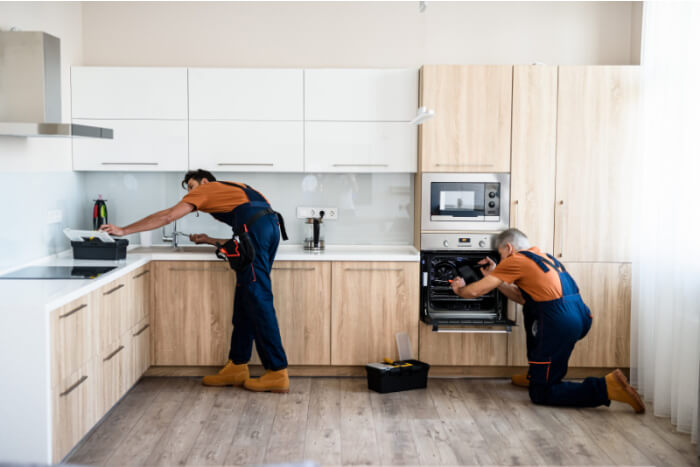Kitchen Remodeling Guide
A kitchen remodel is one of the most impactful ways to improve your home’s functionality, appearance, and resale value. Whether you’re looking to update outdated finishes, improve energy efficiency, or completely change the layout, a well-planned kitchen remodel can transform how you use and enjoy your space. From new cabinets and countertops to upgraded appliances and lighting, every element of your kitchen should work together to create a space that’s practical, stylish, and tailored to your needs.
Remodeling Your Kitchen: What to Know
A kitchen remodel isn’t just about style. It’s about making your kitchen work better for you. Your kitchen is the heart of your home, and remodeling it can improve efficiency, organization, and even energy savings. Common components of a kitchen remodel include cabinets, countertops, flooring, appliances, lighting, and plumbing fixtures. Each material and feature is chosen not only for its appearance but also for its durability and how it supports everyday cooking, dining, and entertaining.
When planning your remodel, it’s important to think about both the big picture and the small details. Factors like kitchen layout, traffic flow, and available storage will play a major role in how well the space works for your family.

How to Plan a Kitchen Remodel
Planning a kitchen remodel involves more than picking out finishes. You’ll want to make sure every element of your project fits your needs and budget. Here’s what to consider when planning:
Set Your Goals: Decide what you want to achieve with your remodel. Are you focused on increasing storage, updating outdated features, or making the space more functional?
Determine Your Budget: Kitchen remodels can range from a few thousand dollars to $50,000 or more. Set a realistic budget early and prioritize where you want to spend and save.
Choose Your Layout: Think about how you use your kitchen. Do you need more prep space, better flow, or an island?
Common layouts include:
- L-Shaped: Maximizes corner space and is ideal for open-concept homes.
- U-Shaped: Offers plenty of counter space and storage.
- Galley: Perfect for small spaces with two parallel counters.
- Island: Adds prep space, storage, and seating.
- Peninsula: Like an island, but attached to a wall or counter.
Pick Your Materials: Select materials that balance durability, appearance, and budget.
Consider options for:
- Cabinets: Solid wood, plywood, MDF
- Countertops: Granite, quartz, laminate
- Flooring: Tile, hardwood, luxury vinyl
- Lighting Fixtures: Task lighting, under-cabinet lights, pendant lights
Hire a Professional: While some homeowners tackle small kitchen upgrades themselves, larger remodels often require licensed contractors to ensure the work is done safely and up to code.
Frequently Asked Questions
Common Elements of a Kitchen Remodel
A kitchen remodel can include a variety of updates, both large and small, to improve the look and functionality of your space. Whether you’re planning a full renovation or a few key upgrades, here are some of the most common elements homeowners choose to remodel:

- Cabinets: New cabinets can transform the entire look of your kitchen. Options include custom cabinetry, semi-custom, or stock cabinets in various styles and finishes.
- Countertops: Popular countertop materials include quartz, granite, laminate, and butcher block. Each offers a different look and level of durability to match your needs and budget.
- Flooring: Replacing old flooring can make your kitchen feel brand new. Common materials include tile, hardwood, and luxury vinyl plank (LVP) — each offering varying levels of durability and water resistance.
- Appliances: Many kitchen remodels include upgraded appliances like refrigerators, ovens, dishwashers, and microwaves. Newer models are often more energy-efficient and can improve your kitchen’s workflow.
- Lighting: Lighting is key to both function and style. Remodels often include task lighting, pendant lights over islands, and under-cabinet lighting to brighten prep areas.
- Sinks & Faucets: New plumbing fixtures, including modern sinks and faucets, can improve both the look and usability of your kitchen.
- Backsplash: Installing a new backsplash is an affordable way to add color, texture, and style while protecting walls from splashes and spills.
- Painting & Wall Coverings: A fresh coat of paint or updated wall coverings can complete your kitchen’s new look.
Other Types of Kitchen Remodel Options
Some homeowners may also choose niche upgrades depending on their space and preferences, such as:
- Open Shelving: For a more modern, airy feel
- Hidden Storage Solutions: Like pull-out pantries or appliance garages
- Smart Kitchen Technology: Touchless faucets, smart refrigerators, and lighting
- Custom Range Hoods or Unique Finishes: To create a statement design piece
Frequently Asked Questions
Topics to Explore
Kitchen Remodel Styles and Options
When it comes to remodeling your kitchen, there’s no one-size-fits-all solution. The right kitchen remodel will depend on your home’s layout, your lifestyle, and your personal design preferences. Whether you’re making small upgrades or starting fresh with a full remodel, it’s important to balance several key factors to ensure your new kitchen is both beautiful and functional.
As you start planning, keep these priorities in mind:
Durability
Choose materials and finishes that can stand up to daily use. Cabinets, countertops, and flooring should be sturdy enough to handle cooking messes, spills, and foot traffic. Popular durable options include quartz countertops, tile or luxury vinyl flooring, and solid wood or plywood cabinets.
Aesthetic Appeal
Your kitchen should reflect your style and complement the rest of your home. Here are a few popular kitchen design themes to inspire you:
- Modern: Sleek cabinets, stainless steel appliances, neutral colors with bold accents
- Farmhouse: Shaker-style cabinets, apron-front sink, warm wood tones, and vintage touches
- Transitional: A balance of classic and contemporary elements, with simple cabinet lines and mixed materials
- Coastal: Light, airy color palettes, white or pale blue cabinets, and natural textures like wood or rattan
- Industrial: Exposed shelving, darker tones, metal finishes, and concrete or butcher block countertops

Functionality
Think about how you use your kitchen every day and design the space to support those needs. Key considerations include:
- Storage: Do you need extra cabinets or a walk-in pantry for food storage?
- Workspace: Would an island or peninsula improve your prep space for chopping, baking, or serving meals?
- Appliances: Are you a serious cook who needs a double oven, or do you need space-saving options for a smaller kitchen?
- Flow: Make sure the layout supports the kitchen work triangle — the distance between your stove, sink, and refrigerator — to make cooking more efficient.
Budget
Set a realistic budget for your project and stick to it. Costs can range from a few thousand dollars for a minor upgrade to $30,000 or more for a full kitchen remodel. Identify which elements, like new cabinets, upgraded appliances, or better lighting, will give you the biggest return on your investment.
Frequently Asked Questions
Common Components of a Kitchen Remodel
A kitchen remodel isn’t just about finishes. It’s about how all the pieces work together to create a functional and beautiful space. Here’s a high-level look at the key components of a kitchen remodel and why they matter:
- Cabinets: Cabinets are the backbone of your kitchen layout. They provide essential storage space for dishes, cookware, and food while also setting the tone for your kitchen’s style.
- Countertops: Countertops are one of the most used surfaces in your home. Whether you choose durable quartz or budget-friendly laminate, your counters need to be both functional and visually appealing.
- Flooring: Kitchen floors need to be tough enough to handle spills, foot traffic, and the occasional dropped dish. Popular options include tile, hardwood, and luxury vinyl plank.
- Lighting Fixtures: Proper lighting is crucial in the kitchen. A well-designed remodel will include ambient, task, and accent lighting to brighten prep areas and create an inviting atmosphere.
- Plumbing Fixtures: Sinks, faucets, and garbage disposals are all vital to your kitchen’s daily function. Many homeowners upgrade to deeper sinks and high-arc, pull-down faucets during a remodel.
- Appliances: Appliances like your stove, oven, refrigerator, and dishwasher are key components of a kitchen remodel. New models can improve efficiency and complement your design aesthetic.
- Electrical & Outlets: Kitchen remodels often include updating outlets, adding USB ports, or installing new lighting circuits to improve safety and convenience.
- Backsplash & Wall Treatments: A new backsplash not only protects your walls but also adds style and personality to your kitchen. Paint or wallpaper can also freshen up the space.
Frequently Asked Questions
Topics to Explore
How to Maintain Your Kitchen After a Remodel
Once your kitchen remodel is complete, ongoing care and maintenance will help protect your investment and keep your space looking and functioning like new. Proper upkeep can extend the life of your cabinets, countertops, flooring, and appliances, saving you money on repairs or replacements in the long run.
Cabinets
- Wipe down cabinet surfaces regularly with a damp cloth and mild cleaner.
- Avoid using harsh chemicals that can damage the finish.
- Tighten loose hinges or handles as needed.
Countertops
- Use cutting boards and trivets to protect countertops from scratches and heat damage.
- Clean spills immediately to prevent staining.
- Reseal natural stone countertops as recommended by the manufacturer.
Floors
- Sweep or vacuum regularly to remove dirt and debris.
- Clean with a non-abrasive cleaner suitable for your flooring material.
- Use mats or rugs in high-traffic areas to prevent wear.
Appliances
- Clean appliance surfaces weekly with gentle, non-abrasive cleaners.
- Check appliance filters and seals regularly and replace or clean as needed.
- Schedule routine maintenance for larger appliances like your refrigerator and dishwasher.
Lighting Fixtures
- Dust light fixtures regularly to keep them clean and bright.
- Replace bulbs with energy-efficient options as needed.
Paint & Wall Treatments
- Wipe down walls and backsplashes to remove grease and splatters.
- Touch up paint or wallpaper as needed to keep your kitchen looking fresh.
Frequently Asked Questions
Kitchen Remodel Costs
The cost of a kitchen remodel can vary widely based on the size of your kitchen, the materials you choose, and the scope of the project. On average, U.S. homeowners spend between $15,000 and $154,000 for a typical kitchen remodel. For smaller updates, costs may be as low as $5,000, while large-scale renovations can exceed $60,000.

Several factors will influence the total cost of your remodel, including:
- Project size and complexity
- Material quality and finishes
- Labor rates in your area
- Structural changes or layout reconfigurations
- Appliance upgrades and custom features
Here’s a breakdown of average costs for common kitchen remodel components:
Cost by Kitchen Element
- Cabinets: $4,000 to $12,000
- Countertops: $1,400 to $5,100
- Flooring: $350 to $3,500
- Lighting Fixtures: $500 to $2,000 or $170 to $570 per fixture
- Sink & Faucet: $700 to $1,900
- Appliances: $3,000 to $8,700
- Electrical & Outlets: $1,400 to $2,400
- Backsplash & Painting: $580 to $1,600
Cost by Kitchen Size
- 10 x 10 kitchen remodeling cost: $15,00 to $25,000
- 12 x 12 kitchen remodeling cost: $21,600 to $36,000
Frequently Asked Questions
Common Issues and Troubleshooting Tips for Kitchen Remodels
Even the best-planned kitchen remodels can come with a few challenges. Being aware of common issues ahead of time can help you avoid delays, unexpected costs, and frustration. Here are some typical problems homeowners encounter during a kitchen remodel—and how to handle them:
Common Kitchen Remodel Issues
- Unexpected Structural Problems: Once walls or floors are opened up, hidden issues like outdated wiring, plumbing problems, or water damage may be uncovered. Tip: Always budget an extra 10-20% for unforeseen repairs.
- Project Delays: Material backorders, permit delays, or contractor scheduling conflicts can slow down your remodel timeline. Tip: Plan ahead and order materials early to avoid long wait times.
- Budget Overruns: It’s easy to go over budget with last-minute upgrades or surprise expenses. Tip: Prioritize must-haves in your budget and leave a cushion for unexpected costs.
- Design or Layout Mistakes: Poor planning can result in awkward workflows, inefficient storage, or insufficient lighting. Tip: Consult with a licensed contractor or kitchen designer to create a functional layout.
- Quality Control: Low-quality materials or inexperienced labor can lead to problems down the road. Tip: Work with licensed, insured contractors and choose durable materials for long-term results.
Frequently Asked Questions
Kitchen Remodel Savings, Rebates, and Environmental Considerations
A kitchen remodel is a big investment, but there are ways to save money and make environmentally friendly choices along the way. Many local, state, and federal programs offer rebates or tax incentives for energy-efficient kitchen upgrades. Choosing eco-friendly materials and appliances can also help reduce your utility bills and environmental footprint.
Ways to Save on Your Kitchen Remodel
- Look for Energy-Efficient Appliances: Choosing Energy Star-certified refrigerators, dishwashers, and ovens may qualify you for rebates and lower your energy costs.
- Check for Tax Credits and Rebates: Visit websites like DSIRE or Energy Star to find local and federal incentives for energy-efficient upgrades.
- Use Sustainable Materials: Eco-friendly options like recycled glass countertops, bamboo flooring, or low-VOC paints can reduce your remodel’s environmental impact.
- Opt for LED Lighting: LED light fixtures use less energy and last longer than traditional bulbs.
- Consider Water-Saving Fixtures: Installing low-flow faucets and water-efficient dishwashers can help conserve water and lower your utility bills.
Frequently Asked Questions
What to Do After Your Kitchen Remodel
Once your kitchen remodel is complete, it’s time to enjoy your new space. But there are also a few important steps to take to protect your investment and ensure everything functions properly.
Post-Remodel Checklist
- Inspect the Work: Walk through the finished kitchen with your contractor to make sure everything meets your expectations and is functioning properly.
- Review Warranties: Keep a copy of warranties for appliances, cabinets, countertops, and any other major upgrades. Understand what’s covered and how long coverage lasts.
- Schedule Routine Maintenance: Regular cleaning and inspections can help extend the life of your remodel. Check for leaks, loose hardware, or wear and tear on floors and surfaces.
- Keep Contractor Contact Info Handy: If you have questions or notice issues after the remodel, having your contractor’s contact information readily available will make follow-up easier.
- Learn How to Use New Features: Take time to understand how to use and maintain new appliances, fixtures, and finishes to get the most out of your remodel.
Frequently Asked Questions
Ready to get your project started?
Let us find the best kitchen-remodel pros in your area, then easily request quotes, book a contractor, and get the job done. It's that easy.

Homeowner Resources
Here are the top articles that homeowners found useful when planning their kitchen remodel project and navigating the contractor hiring process.

Real Stories, Real Success
See how our solutions empower homeowner projects and experiences.

